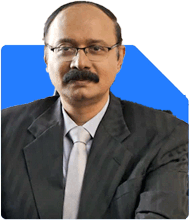42-Year-Old with 1 Lakh Monthly Income: How to Invest for a 9 Cr Retirement Corpus?
Ramalingam Kalirajan |10893 Answers |Ask -Follow
Mutual Funds, Financial Planning Expert - Answered on Jan 16, 2025
He has an MBA in finance from the University of Madras and is a certified financial planner.
He is the director and chief financial planner at Holistic Investment, a Chennai-based firm that offers financial planning and wealth management advice.... more

Hello, I'm 42 yrs old with a monthly income of 1lakh, planning to buy a house this year on loan of approx 50lakhs which can take approx. 45K as emi with the balance cash pls suggest were to invest so that by retirement i can have around 9cr to 10cr income. Currently I have zero invest i know i'm late but will help if you can suggest best possible option
1. Assess Your Current Financial Situation
Your monthly income is Rs. 1 lakh.
After paying an EMI of Rs. 45,000, Rs. 55,000 remains for expenses and investments.
You plan to retire in around 18 years, which gives ample time for compounding.
2. Allocation of Disposable Income
2.1 Emergency Fund Creation
Set aside six months of expenses, around Rs. 3-5 lakh, in a liquid fund.
This provides safety during unforeseen events.
2.2 Insurance Protection
Buy a term insurance policy covering 15-20 times your annual income.
Ensure adequate health insurance for your family.
2.3 Investment Amount
Dedicate Rs. 30,000-35,000 per month towards investments.
Gradually increase investments with salary increments.
3. Investment Strategy
3.1 Start with Equity Mutual Funds
Invest 75-80% of your surplus in equity mutual funds for long-term growth.
Diversify across large-cap, mid-cap, and flexi-cap funds.
Actively managed funds can outperform benchmarks, making them preferable.
Advantages of Actively Managed Funds:
Expert fund managers identify opportunities in changing market conditions.
They provide higher returns compared to passive index funds in India’s dynamic markets.
3.2 Include Debt Funds
Allocate 15-20% of your portfolio to debt funds.
These reduce portfolio volatility and provide stability.
Short-term and corporate bond funds are suitable options.
3.3 Explore ELSS Funds for Tax Savings
Invest in Equity Linked Savings Schemes (ELSS) for tax benefits under Section 80C.
This adds to your retirement corpus while saving taxes.
3.4 Use SIPs for Consistent Investments
Systematic Investment Plans (SIPs) help average costs during market ups and downs.
Set SIPs aligned with your salary cycle for discipline.
4. Long-Term Asset Allocation
4.1 Equity-Debt Ratio
Maintain an equity-debt ratio of 80:20 initially for growth.
Shift to 60:40 as you approach retirement to protect gains.
4.2 Periodic Rebalancing
Review and rebalance your portfolio annually.
This ensures the allocation aligns with your goals and risk tolerance.
5. Avoid Mistakes and Stay Focused
5.1 Don’t Delay Investments
Every delay reduces compounding benefits.
Start SIPs immediately to maximize returns.
5.2 Avoid Overdependence on Real Estate
Real estate offers low liquidity and inconsistent returns.
Focus on liquid, growth-oriented financial assets.
5.3 Stick to Your Plan
Avoid withdrawing investments prematurely.
Stay invested during market corrections to benefit from recovery.
6. Leverage Salary Increments
Step up SIPs by 10-15% annually with salary hikes.
This small adjustment ensures you meet your retirement target comfortably.
7. Tax Efficiency of Mutual Funds
7.1 Equity Funds
Long-term capital gains (LTCG) above Rs. 1.25 lakh are taxed at 12.5%.
Short-term capital gains (STCG) are taxed at 20%.
7.2 Debt Funds
Gains are taxed as per your income tax slab.
Plan redemptions strategically to minimize tax outgo.
8. Monitor and Review Investments
Track your portfolio’s performance every six months or annually.
Replace underperforming funds while maintaining overall diversification.
9. Final Insights
Your decision to plan now is a step in the right direction.
Focus on equity funds for long-term growth and debt funds for stability.
Start SIPs immediately and gradually increase contributions.
Avoid over-reliance on real estate and stick to liquid financial assets.
Disciplined investments, regular reviews, and a clear focus will help you achieve your retirement goal.
Best Regards,
K. Ramalingam, MBA, CFP,
Chief Financial Planner,
www.holisticinvestment.in
https://www.youtube.com/@HolisticInvestment
You may like to see similar questions and answers below
Ramalingam Kalirajan |10893 Answers |Ask -Follow
Mutual Funds, Financial Planning Expert - Answered on Jun 22, 2024
Ramalingam Kalirajan |10893 Answers |Ask -Follow
Mutual Funds, Financial Planning Expert - Answered on Jul 13, 2024
Ramalingam Kalirajan |10893 Answers |Ask -Follow
Mutual Funds, Financial Planning Expert - Answered on May 29, 2025
Reetika Sharma |425 Answers |Ask -Follow
Financial Planner, MF and Insurance Expert - Answered on Oct 04, 2025
Ramalingam Kalirajan |10893 Answers |Ask -Follow
Mutual Funds, Financial Planning Expert - Answered on Dec 15, 2025
Ramalingam Kalirajan |10893 Answers |Ask -Follow
Mutual Funds, Financial Planning Expert - Answered on Dec 15, 2025
Radheshyam Zanwar |6746 Answers |Ask -Follow
MHT-CET, IIT-JEE, NEET-UG Expert - Answered on Dec 15, 2025
Ramalingam Kalirajan |10893 Answers |Ask -Follow
Mutual Funds, Financial Planning Expert - Answered on Dec 15, 2025
Ramalingam Kalirajan |10893 Answers |Ask -Follow
Mutual Funds, Financial Planning Expert - Answered on Dec 15, 2025
Ramalingam Kalirajan |10893 Answers |Ask -Follow
Mutual Funds, Financial Planning Expert - Answered on Dec 15, 2025
Samraat Jadhav |2508 Answers |Ask -Follow
Stock Market Expert - Answered on Dec 15, 2025
Ramalingam Kalirajan |10893 Answers |Ask -Follow
Mutual Funds, Financial Planning Expert - Answered on Dec 15, 2025
Reetika Sharma |425 Answers |Ask -Follow
Financial Planner, MF and Insurance Expert - Answered on Dec 15, 2025
Radheshyam Zanwar |6746 Answers |Ask -Follow
MHT-CET, IIT-JEE, NEET-UG Expert - Answered on Dec 15, 2025
























